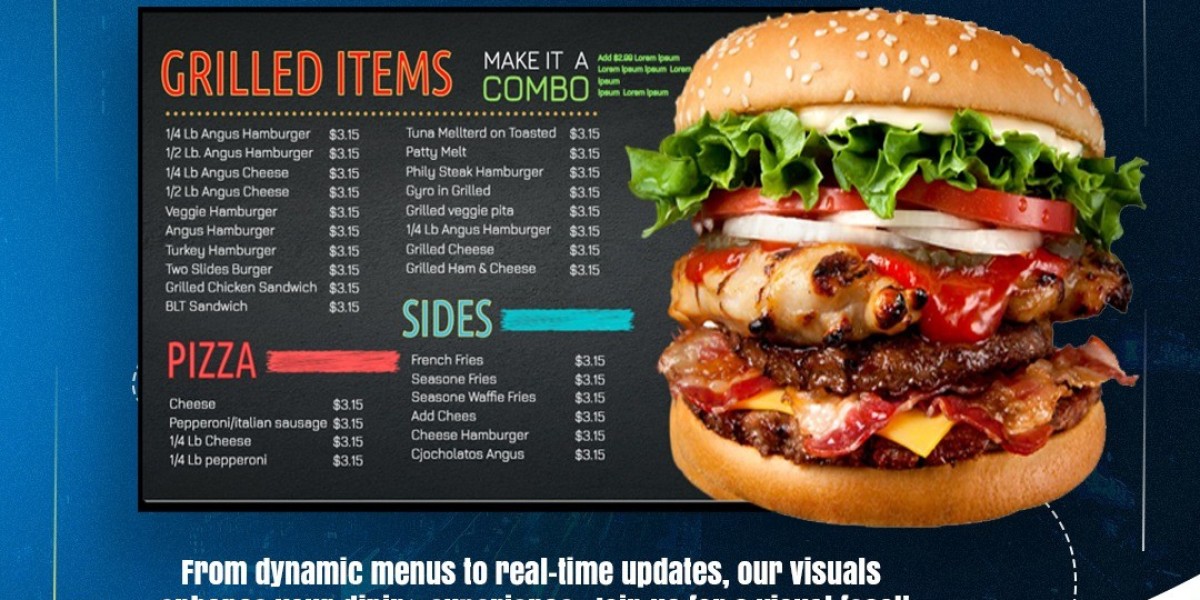In today's fast-paced and competitive restaurant industry, standing out and making a memorable impact is crucial for success. One innovative way to achieve this is by utilizing a restaurant digital menu. Gone are the days when chalkboards or static printed menus could meet customer expectations. Now, digital signage software enables restaurants to display dynamic, engaging, and customizable digital menus that enhance the overall dining experience. But how do you choose the right digital menu for your restaurant? Here’s a guide to help you make the right choice.
1. Understand Your Restaurant’s Needs
Before diving into digital signage options, it's essential to assess your restaurant's specific needs. Every restaurant operates differently, so you need to consider how your digital menu will serve both your customers and staff. Here are a few questions to guide you:
- Do you run a fast-casual or fine dining establishment?
- Do you need multiple screens, or will one suffice?
- How often do you change your menu?
- Do you want to promote limited-time offers or special events?
Understanding the demands of your restaurant helps narrow down your options when choosing restaurant digital menu solutions that align with your goals.
2. Key Features to Look for in Digital Menu Software
Not all digital signage software is created equal. Some solutions come with advanced features tailored to specific business needs. Here’s a rundown of some must-have features to look for when selecting a digital menu:
a. User-Friendly Interface
Choose software that is easy to use for your staff. A user-friendly interface will reduce the learning curve and help you avoid complications when updating menus, adjusting prices, or adding new items. Your staff should be able to make these changes quickly and without technical support.
b. Customizable Templates
Templates are one of the best features of digital signage software, enabling you to maintain consistency while tailoring your menu to your brand. Look for software with customizable templates, allowing you to change colors, fonts, images, and layout to match your restaurant’s theme and ambiance.
c. Menu Scheduling
One key benefit of using a restaurant digital menu is the ability to schedule different menus based on the time of day. If your restaurant serves breakfast, lunch, and dinner, you’ll want software that allows you to automatically rotate menus. Look for scheduling features that enable you to easily switch between meal times or seasonal offerings.
d. Cloud-Based Accessibility
Cloud-based digital signage software allows you to manage your restaurant’s menu from any location. Whether you have one or multiple locations, cloud-based software provides real-time control and updates. It also offers backup options to ensure your data is secure, reducing the risk of losing valuable menu information.
e. Integration with POS Systems
A seamless integration between your restaurant digital menu and point-of-sale (POS) system is critical for smooth operations. When your digital menu updates in real-time with your POS system, inventory is tracked accurately, and customers always see the correct pricing. It also helps avoid the embarrassment of promoting items that are sold out.
f. Support for High-Quality Media
Your digital menu should be more than just text. To capture customer attention, use high-quality images, videos, and animations. Make sure the software you choose supports various multimedia formats and allows you to integrate these visuals effortlessly.
3. Choosing the Right Hardware
Selecting the right hardware is just as important as the software for your digital menu. Depending on your restaurant’s layout, you might need multiple screens or a large central display. Here are a few tips for choosing the right hardware:
a. Screen Size and Resolution
The size of your digital menu board depends on your restaurant's space and the distance from which customers will be reading the menu. Larger screens with higher resolution work well in fast-food or quick-service restaurants, where menus need to be viewed from a distance. Ensure that your display supports high-definition visuals, as blurry images can negatively impact customer perception.
b. Durability and Maintenance
Your restaurant environment can affect the longevity of your digital screens. For example, if your digital menu is placed near a kitchen, the heat and moisture might wear down the screen over time. Consider investing in durable screens that are designed to withstand such conditions. Also, look for screens that are easy to clean and maintain.
c. Touchscreen Functionality
Interactive touchscreen menus are becoming increasingly popular in quick-service restaurants and cafes. If you’re considering a self-service option, touchscreen menus can reduce wait times, improve accuracy, and provide a more engaging experience for customers.
4. Cost Considerations
When investing in a restaurant digital menu, cost will inevitably be a factor. There are several costs to consider:
Upfront Costs: These include purchasing hardware like screens, mounts, and media players. While it may seem like a significant investment upfront, digital menus typically offer long-term savings by reducing printing costs.
Subscription Fees: Many digital signage software providers charge monthly or yearly subscription fees. Some offer tiered pricing models depending on the features you need, so be sure to choose a package that fits your budget and requirements.
Ongoing Maintenance: Digital menus require occasional updates and repairs. While most issues can be managed remotely with cloud-based software, you may still need to factor in occasional hardware maintenance or replacement costs.
5. Future-Proof Your Investment
Technology is always evolving, and your digital menu should be able to adapt to future changes. When choosing a restaurant digital menu, opt for software and hardware that offer scalability. As your business grows, you may need additional screens or advanced features such as real-time analytics or mobile integration. Look for software that is regularly updated and allows for new features to be integrated easily.
6. Partner with a Reliable Digital Signage Provider
Choosing the right provider for your digital signage software is just as important as the technology itself. Partner with a reputable company that offers strong customer support, easy-to-use solutions, and reliable hardware. Read reviews, ask for references, and request demos to ensure the provider you select understands the unique needs of your restaurant.
Conclusion
Selecting the right restaurant digital menu can enhance your customers’ experience, streamline your operations, and ultimately boost your sales. By choosing software with customizable templates, real-time menu scheduling, and cloud-based accessibility, paired with the right hardware, you can create a digital menu that is functional, attractive, and future-proof.
As digital menus become a growing trend in the restaurant industry, now is the time to embrace this technology to set your restaurant apart.



